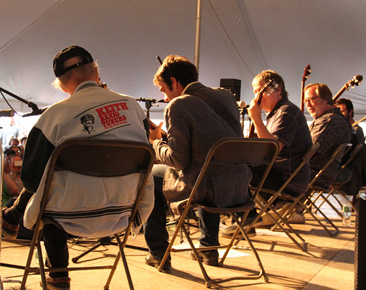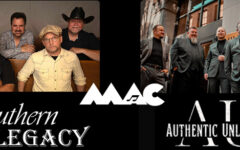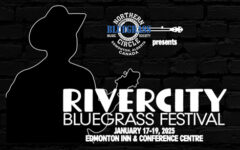
 Bela Fleck, Tony Trischka and six other banjo greats honored 75-year-old Bill Keith Friday, July 17 at the Grey Fox Bluegrass Festival in what was dubbed the Keith-Style Banjo Summit.
Bela Fleck, Tony Trischka and six other banjo greats honored 75-year-old Bill Keith Friday, July 17 at the Grey Fox Bluegrass Festival in what was dubbed the Keith-Style Banjo Summit.
Fans packed the Creekside Stage tent to listen to the tribute and get a glimpse of Keith, who was helped on stage with the aid of a walking cane. Wearing a gray Keith Banjo Tuners jacket and a black NY Banjo cap, the “banjo Jedi master,” as Ryan Cavanaugh described him, was too frail to bring a banjo on stage and play. Instead, he listened along with the audience in the best seat in the house.
Joining Fleck, Trischka and Cavanaugh were Noam Pikelny, Mike Kropp, Eric Weissberg, Marc Horowitz and Mike Munford.
“Most of us wouldn’t be up here today without Bill,” Trischka said.
Born in Boston in 1939 and graduating from Amherst College in 1961, Keith spent nine months with Bill Monroe & the Blue Grass Boys in 1963, recording a groundbreaking song — Devil’s Dream — with what became known as the Keith style of banjo picking. The song, recorded a year earlier with Jim Rooney on the Livin’ on the Mountain LP, wasn’t groundbreaking because of the song itself but because of the way Keith was playing.
“Do you want to say anything about Devil’s Dream?” Trischka asked.
“I first heard this tune played by a Nova Scotian fiddler, and it just dawned on me, I could see in my mind how to play it in the melodic style,” Keith said. “Fortunately, it was a simple tune because if it were anything more complicated, it might not have happened.”
For those in the audience unfamiliar with the Keith style, Fleck said it is “sometimes oversimplified to ‘playing fiddle tunes on the banjo,’ but it’s a whole lot more than that.”
“Is there anybody who could elegantly explain the fiddle tune part of it?” Fleck asked. “Maybe Tony Trischka.”
 “It’s a banjo workshop suddenly,” Trischka said. “I’m sorry, we’re going to geek out just for a second. Bear with me. When you’re doing the Scruggs style, a lot of the notes are not melody notes; they’re just kind of filler notes. Like you take the chord and just break it up into the individual notes. In the melodic style that Bill developed and created on his own and popularized when he was with Bill Monroe back in 1963, he came up with a style with is based on scales, which suddenly allowed you to play fiddle tunes note for note.”
“It’s a banjo workshop suddenly,” Trischka said. “I’m sorry, we’re going to geek out just for a second. Bear with me. When you’re doing the Scruggs style, a lot of the notes are not melody notes; they’re just kind of filler notes. Like you take the chord and just break it up into the individual notes. In the melodic style that Bill developed and created on his own and popularized when he was with Bill Monroe back in 1963, he came up with a style with is based on scales, which suddenly allowed you to play fiddle tunes note for note.”
When Fleck said “oversimplified,” he was just talking about the technique.
“But what Bill has brought to the banjo is so much more from the jazz chords, but mostly an elegance in his playing,” Fleck said.
“Thank you,” Keith said.
“We always talk about Earl Scruggs starting with three-finger style,” Fleck said. “There were other guys who played three-finger around that time, but it was the musicality that is why we’re still talking about it. And I think that’s also true of Bill.”
Fleck then played Devil’s Dream and Sailor’s Hornpipe before reading the first of a couple of quotes from other famous banjoists who weren’t at the summit.
“Here’s a note from Steve Martin, the banjoist, actor, writer, comedian,” Fleck said. “‘There is Earl Scruggs. There is Pete Seeger. And there is Bill Keith. They are the towering founders of modern banjo playing.’ Are we embarrassing you enough yet, or should we step it up a little bit?”
“Is my face red yet?” Keith replied.
After a few words about Keith, Pikelny played Beating Around the Bush.
“I haven’t written a lot of pieces of music, but that’s one of my favorites,” Keith said after Pikelny finished. “In some ways, I think the level of difficulty adds to my enjoyment … and I think it met its match with you guys.”
Another quote was read by banjoist Murphy Henry, who wasn’t in attendance. She referred to Keith’s contribution to the Earl Scruggs instructional book. When he was learning banjo, Keith spent hours listening to Scruggs’ records and wrote down the tablature, which Scruggs eventually used for his book.
“It’s not only the men who have been influenced by Bill Keith,” Murphy wrote. “I am just one of the many female banjo players who owes a great deal to the musical prowess of this master of the five-string. Bill Keith was my door into Scruggs style of banjo playing. As a newbie, I didn’t yet know about Bill, but I had the Earl Scruggs banjo book. Knowing just enough about reading music to hurt my playing, I found I could only make sense of the tabs by slowing down vinyl LPs of Earl’s playing. I would figure out as much as I could and then turn to Bill’s immaculate tabs to see if I got it right. I trusted Bill’s tabs with my entire banjo being. Later on I came to admire Bill’s own playing. Much later I got to meet Bill himself and hear all about the circle of fifths. I always felt honored to be in his mighty presence, and I am with you all in spirit today.”
 Cavanaugh told a story about the first time he met Keith. It was 1997, and he was 17 years old attending the Winterhawk Bluegrass Festival, which is now called the Grey Fox Bluegrass Festival. Cavanaugh was looking for his uncle.
Cavanaugh told a story about the first time he met Keith. It was 1997, and he was 17 years old attending the Winterhawk Bluegrass Festival, which is now called the Grey Fox Bluegrass Festival. Cavanaugh was looking for his uncle.
“This man was extremely overweight,” Cavanaugh said. “He wore black Velcro shoes with black crew socks and a Harley-Davidson shirt. He had a mullet, and he wore an Abe Lincoln top hat with a parrot feather in it. I didn’t know where this man was until I saw a teepee on the horizon.”
Cavanaugh had never met Keith before, so he didn’t recognize him at the teepee.
“I would have known who he was if he looked like the man on the tuner box, but I hadn’t seen a picture of him in years,” Cavanaugh said. “And he said to me, ‘Are you related to this guy?’ I said, ‘Yeah, I’m related to this guy.’ He goes, ‘Well get him the hell out of here. He’s driving me nuts.’ And I looked at my uncle, and I said, ‘Get the hell out of here. You’re driving this guy nuts.'”
So Cavanaugh sat down and played banjo with his 17-year-old friend and Keith. Then his friend left.
“It was just me and Bill,” Cavanaugh said. “I said, ‘You know I should probably leave right now. Thanks for sitting here for like two hours and playing Autumn Leaves with me. Who are you, man?’ He’s like, ‘I’m Bill Keith.’ And I was like, ‘Holy shit! You’re Bill Keith.’ I hung out for another two hours, and we’ve been friends ever since.”
As an inventor, Keith has also made contributions to the mechanical side of the banjo, developing what is known as the Keith Banjo Tuner. This banjo peg allows banjo players to quickly change from one open tuning to another while playing, and it is still a product of Keith’s business, the Beacon Banjo Company, based in Woodstock, New York.
Fleck demonstrated the Keith Banjo Tuner by playing Katmandu.
“I also use them because they are better tuners,” Fleck said. “They were finer tuners, and so it gave me a more refined tuning peg to use. Also I discovered, strangely enough, that they change the sound of the banjo in a way that I found to be very positive. There was a tonal change by having the four pegs on. A part of the sound of this banjo is not just that it’s a pre-war flathead from the ’30s, but it’s also got these four bulky metal pegs that change the mass of the neck. To me, it’s a positive thing.”
The tribute lasted more than 90 minutes with all guest banjoists given a chance to talk and play. The summit was the first opportunity Grey Fox had to honor Keith after he was given an International Bluegrass Music Association Distinguished Achievement Award in October 2014.
Editor’s Note: The video above contains audio of Bill Keith performing Devil’s Dream live on stage with Bill Monroe & the Blue Grass Boys in 1963, taken from the Acoustic Disc album, Bill Monroe & The Blue Grass Boys Live at Mechanic’s Hall. In the clip, Monroe refers to Bill as Brad, the name he assumed when he joined the band, as Big Mon wouldn’t have two Bills in the band.







